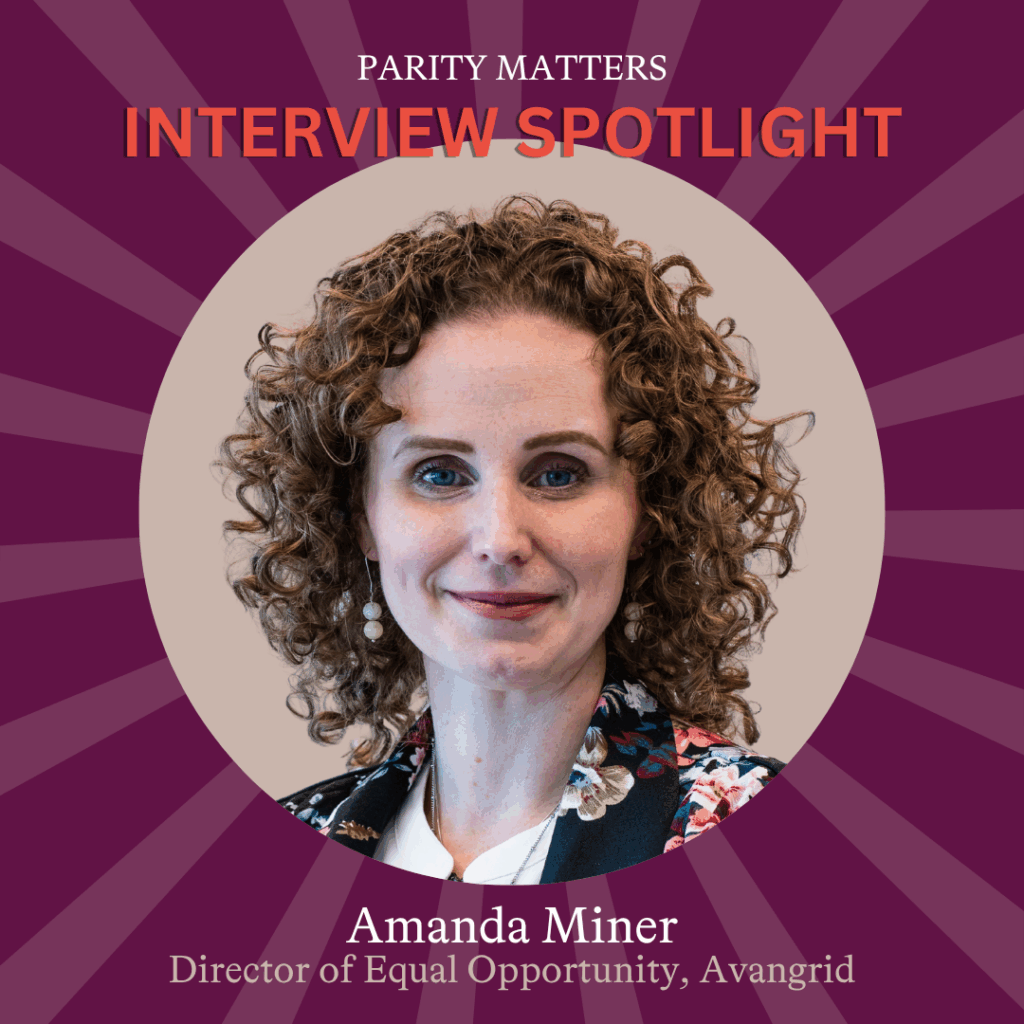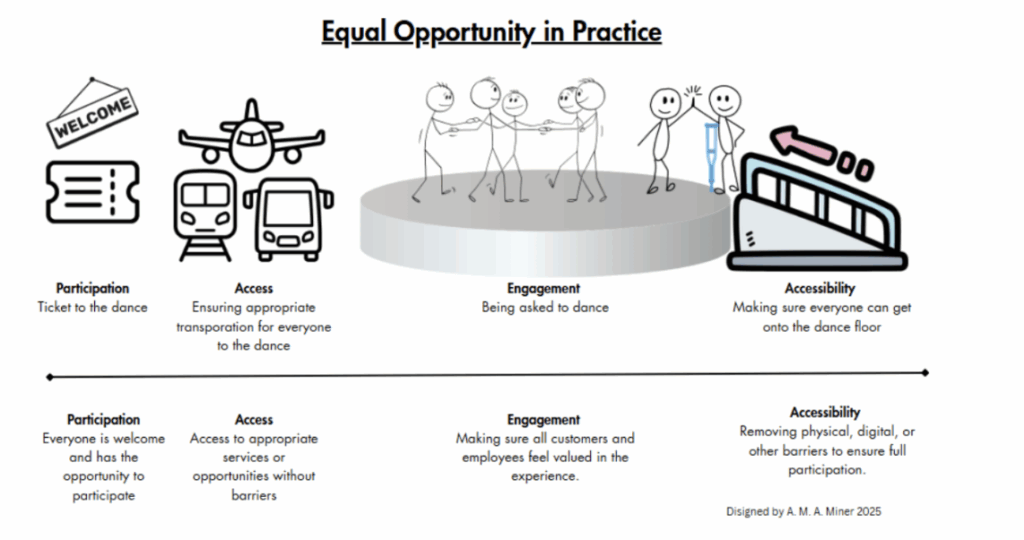
Name: Amanda Miner
Title: Director of Equal Opportunity, Avangrid
My name is Amanda Miner, and I am the Director of Equal Opportunity at Avangrid. In my role, I lead initiatives that foster a workplace where every individual—regardless of gender, background, or ability—has the opportunity to thrive. With nearly 13 years at Avangrid, my journey through various departments has shaped a deep understanding of the systemic and cultural shifts needed to create lasting equality.
In 2021, I co-founded and continue to Chair CARE, an intersectional Employee Resource Group (ERG) dedicated to advancing understanding and support for individuals with disabilities, caregivers, and allies. CARE’s mission—to celebrate differences, build bridges, and empower individuals—reflects the broader values I champion across all seven of our ERGs. These groups are vital platforms for elevating all voices and cultivating expansive leadership pipelines.
Our ERGs regularly host informative sessions that deepen awareness of our multifaceted identities and cultivate a culture of empathy and belonging. In parallel, our Equal Opportunity team delivers annual company-wide trainings that reinforce our core values and equip employees with the tools to embrace multiple perspectives, champion accessibility, and lead with equality and intention.
I also contribute to this learning culture by guest speaking and lecturing on topics such as Constructive Strategies for Fair Conflict Resolution, Leading with Intentionality, and Disability Etiquette in the Workplace. These sessions are designed to help leaders and teams navigate challenges with empathy, clarity, and purpose while fostering respectful and inclusive environments.
My work is grounded in strategy and action. We are driving measurable progress in gender parity, accessibility, and equitable career development. We’ve partnered with organizations like Paradigm for Parity, NEWIEE, and Disability:IN to ensure our efforts are informed, impactful, and aligned with industry best practices.
By embedding the principles of equality into leadership development, workforce planning, and community engagement, I aim to create an environment where women—and all employees—can lead with authenticity, confidence, and purpose.
We live in a world that often emphasizes constant movement—always climbing, always chasing the next opportunity. But one of the most valuable lessons I’ve learned came from a mentor outside of my career. They reminded me of the importance of simply being—of appreciating where you are without always focusing on where you’re going next.
That perspective has been transformative. When we’re always looking ahead, we risk missing the richness of the present moment. I’ve genuinely enjoyed each of my roles at Avangrid, but my current position with Equal Opportunity has been especially meaningful. For the first time, I find myself fully immersed—actively cherishing the work I’m doing and the impact it’s having on my colleagues and the community.
This role has helped quiet the internal noise and resist the external pressure to constantly plan the next move. Instead, I’m learning to value the now—and that has made all the difference.
When I reflect on my career path, I often think about how I might not be in the position I hold today without one particular Vice President who saw something in me. We first connected when I was just a few years into the company. I had asked to meet with her as a mentor, and I still remember her presence—poised, humble, and tough, all wrapped in elegance.
Later, when an opportunity arose to interview for a role on her team, I remember feeling truly heard. She wasn’t just waiting for her turn to speak—she was listening. I only had the chance to work directly with her for a few months before she retired, but her mentorship, guidance, and ultimately her sponsorship changed the trajectory of my career. To this day, we still exchange holiday cards—a small but meaningful reminder of the impact she had on my journey.
But I’ve also learned that while external advocates are invaluable, we must also learn to be our own sponsors. That can be hard. Many of us have been taught that speaking about our accomplishments is bragging, and that humility means staying quiet. But the truth is, we can’t always wait for someone else to open the door—we have to knock ourselves.
For me, that meant pushing through anxiety to directly ask one of our company presidents for development opportunities. It meant asking someone to be my mentor, even when I wasn’t sure what the answer would be. Those moments of self-advocacy were uncomfortable—but they were also the spark that ignited real momentum in my career.
Sponsorship, whether from others or from within, is what helps us grow. And sometimes, the most powerful advocate you can have is yourself.
As someone with Generalized Anxiety Disorder and AuDHD (Autism and ADHD), both diagnosed later in life, I’ve learned firsthand how difficult it can be to advocate for yourself in the workplace. Especially when you’re high masking and perceived as having low support needs, it’s easy for others to assume your experience is mild. But just because you experience my AuDHD mildly doesn’t mean I do.
That’s why I believe one of the most powerful things a manager or leader can do is to ask—not just once, but regularly and intentionally—“What can I do to make your work more accessible or adaptable so you can thrive?” When we ask this question with sincerity and without judgment, we lower the threshold of fear that often comes with requesting accommodations. Because let’s be honest: asking for flexibility, leave, or support can feel like a risk. There’s a power imbalance between the person asking and the person being asked, and that imbalance can silence even the most pressing needs.
I try to model a different approach. When I check in with someone, I don’t just ask if they need anything—I offer examples. Maybe it’s flexible hours, asynchronous communication, or a quieter workspace. Giving people a menu of possibilities helps take the pressure off them to figure out what’s “acceptable” to ask for.
And when it comes to caregiving, we often forget the immense mental and physical load it carries. We’re quick to accommodate a disability, but slower to recognize the toll of caring for someone else. That’s why I try to offer as much flexibility as possible within the bounds of the role and in fairness to the team.
So the real question is: Are we creating environments where people feel safe to be honest about what they need? And if not, what can we do—today—to change that?
When I think about inclusion, I’ve started using a framework that I built around four key concepts: participation, access, engagement, and accessibility. I often describe it through the traditionally used metaphor of a dance—because inclusion isn’t just about being invited, it’s about being able to fully show up and take part. Participation is the ticket to the dance—the formal invitation that says, “You belong here.” Access is the transportation to get there. If I’m two blocks away, do I need a helicopter, a car, or can I walk? Engagement is being asked to dance once I arrive rather than being left to stand around the outside edge of the floor. But none of that matters if I can’t actually get onto the dance floor. That’s where accessibility comes in—it’s the foundation that ensures everyone can participate meaningfully, not just symbolically.
What I want people to know with this model is that engagement or inclusion isn’t a single action—it’s a system of intentional design. It’s not enough to just open the door; we have to make sure people can get through it, feel welcomed when they arrive, and have what they need to thrive once they’re inside. Whether we’re talking about physical spaces, digital tools, leadership opportunities, or workplace culture, true engagement / inclusion means removing barriers to participation at every step. When we build with accessibility in mind from the start, we don’t just make space—we create momentum for everyone to move, grow, and succeed together.
I don’t think this can be included based on your format – but this is how I visually show it to folks:

Yes, the movements toward gender parity and disability rights absolutely intersect—and that intersectionality is something I emphasize in every conversation I have. These movements both challenge deeply rooted stereotypes about who belongs where, who is capable, and who deserves support. For example, when men are primary caregivers—as is my husband—they often face bias because caregiving is still seen as a “woman’s role.” That same bias can silence their need for flexibility or accommodations, just as women and gender-diverse individuals are often confined by narrow definitions of leadership, strength, or career paths. These stereotypes don’t serve anyone. Breaking them begins with recognizing that none of us are just one thing. I’m not only a woman, a mom, or a person who is neurodivergent and disabled—I’m all of those things. And our male, non-binary, and gender-diverse colleagues are just as multifaceted.
Disability rights, in particular, have historically lagged behind other equity movements. For too long, disability was left out of traditional DEI conversations. I remember saying, “If we’re not including accessibility, we’re leaving so many behind.” Only more recently have we seen the shift to DEIA or DEIB, where accessibility and belonging are finally named. At Avangrid, we use the language of Equal Opportunity because our goal isn’t just inclusion—it’s creating a workplace rooted in belonging and equality, where every person has the opportunity to succeed. That means recognizing that we may need
different supports or paths to get there, but the goal is the same: to cross the finish line together. A workplace where everyone can see over the fence—not because we’re the same, but because we’re all valued equally.
What I wish more people understood about disability rights is that disability is far more common—and far more nuanced—than many realize. One in four adults in the U.S. identifies as having a disability, and around 80% of disabilities are acquired between the ages of 18 and 64. However, so many people hesitate to identify as disabled because of the stigma attached to the label—fearing they’ll be seen as a burden, less capable, or “not enough.” Ask yourself: what’s the first image that comes to mind when you hear the word “disability”? Did you picture someone who looks like you? Because 80–90% of disabilities are invisible. Being a person with a disability is one of the few protected characteristics that anyone can join at any point in life—through birth, accident, illness, or aging. However, it is one that we fear the most because of the stigmas and the lack of accessibility in our world.
Disability rights and inclusion isn’t just about ramps and parking spaces—it’s really about rethinking how we can design the world. Did you know that so many of our everyday technologies or goods were originally created for people with disabilities? The flexible straw was invented to help hospital patients drink while lying down; curb cuts were demanded by disability activists and now benefit parents with strollers, travelers with luggage, and delivery workers; universal remotes were developed to simplify access for people with mobility challenges; and sit/stand desks were first introduced as accommodations for people with chronic pain or mobility needs! Accessibility doesn’t just benefit or help one single group—it helps everyone.
Amanda Miner is the Director of Equal Opportunity at Avangrid
Amanda Miner is the Director of Equal Opportunity at Avangrid